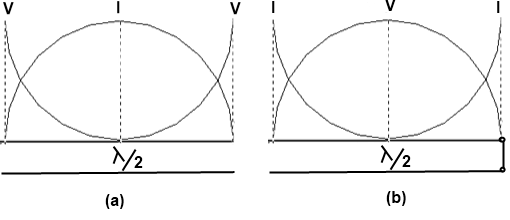Half & Quarter Wave Length Transmission Lines
Half Wave Length Transmission Line
As shown in the given diagram the half-wavelength transmission line can be open-circuited or short-circuited. The length of the transmission line is valid only for the particular frequency at which λ/2 of that transmission line is calculated other than that frequency. The transmission line will not behave as a half-wavelength line.
As shown in diagram No. (a), the half-wavelength transmission line is open-circuited. In this case, at the load end or at the last end the voltage will be maximum and the current will be minimum. This behavior is repeated at the starting end of the same transmission line. It means that at this starting end of the half-wavelength transmission line, the voltage will be also maximum and the current will be minimum.

As shown in diagram No. (b) The half-wavelength transmission line is short-circuited. In this case, at the load end or at the last end the voltage will be minimum and the current will be maximum. This behavior is repeated at the starting end of the same transmission line. It means that at the starting end of the half wavelength line, the voltage will be also minimum and the current will be maximum.
Key Characteristics
Some key characteristics of half-wavelength (λ/2) transmission lines include:
- The electrical length of 180 degrees - A λ/2 line produces a 180° phase shift from input to output
- Impedance inverting - The input and output impedances are inverted (Zout = 1/Zin)
- Maximum power transfer - When Zout = Zload, maximum power is transferred
- Resonant behavior - λ/2 lines act like parallel RLC resonators at their resonant frequency
- Voltage magnification - The output voltage is multiplied relative to the input voltage
- Structural resonance - The line acts like an open or short circuit at odd multiples of λ/4 points
Applications
Half-wavelength lines are commonly used for:
- Impedance matching between mismatched components
- Resonant filters and parallel resonant circuits
- Voltage amplification and phase reversal
- Structurally resonant antenna elements
- Maximizing power transfer to a load
The unique characteristics make λ/2 transmission lines useful for RF matching, filtering, and resonance applications. The dimensions and impedance determine the frequency response.
Merits
Impedance inversion - This allows impedance matching between mismatched components, enabling maximum power transfer.
- Resonance - Half-wave lines act as resonant LC circuits, useful for filtering and oscillator circuits.
- Phase shift - The 180° phase reversal is useful for phase matching in circuits and antennas.
- Voltage gain - Stepped-impedance lines can provide voltage magnification.
- Structural resonance - The open/short behavior provides a resonant antenna structure.
- Simplicity - Just one element can provide multiple useful characteristics.
Demerits
- Narrowband - The properties only apply at the resonant design frequency. Not suitable for wideband applications.
- Specific length - The length must match half the wavelength, limiting physical design.
- Losses - Longer lines introduce more conductor and dielectric losses.
- Power handling - High voltage magnification can overstress components.
- Spurious response - Transmission line resonant effects can cause unwanted harmonics.
- Phase distortion - Non-linear phase near resonance can distort signals.
In summary, half-wave lines provide useful properties like impedance matching, resonance, and phase shift that make them effective in narrowband RF and microwave circuits. But their inherent limitations in bandwidth, physical length, and potential for distortion must be considered.
Quarter Wave Length Transmission Line
As shown in the given diagram the quarter wavelength transmission line can be open-circuited or short-circuited. The length of the transmission line is valid only for a particular frequency at which λ/4 of the transmission line is calculated other than that frequency the transmission line will not behave as a quarter wavelength transmission line.

As shown in diagram No. (c) The quarter wavelength transmission line is open-circuited. In this case, at the load or at the last end the voltage will be maximum and the current will be minimum. This behavior is repeated at the starting end of the same transmission line. It means that at the starting end of the quarter wavelength transmission line the voltage will also be maximum and the current will be minimum.
As shown in diagram No. (d) The quarter wavelength transmission line is short-circuited, in this case at the load end or at the last end the voltage will be minimum, and the current will be maximum, this behavior is repeated at the starting end of the same transmission line. It means that at the starting end of the quarter wavelength transmission line, the voltage will be maximum and the current will be minimum.
The quarter wavelength transmission line is used for the matching purposes of the impedance. It is known as stub matching of the load impedance.
Zo = Characteristics Impedance
Zs = Source Impedance
Characteristics of Quarter-Wavelength Lines
- The electrical length of 90 degrees - A λ/4 line produces a 90° phase shift from input to output
- Impedance transforming - The impedance is transformed based on the line's characteristic impedance Z0 and load impedance ZL according to
Zin = Z0^2 / ZL - Maximum power transfer -
When
Z0 = √(Zin x ZL),
the impedance is matched for maximum power transfer - Resonant behavior - λ/4 lines act like series resonant circuits at frequencies where the line is λ/4 long
Applications
- Impedance matching - λ/4 lines commonly used for matching between mismatched components
- Impedance transformation - Allows transforming from one impedance level to another, e.g. matching 50Ω to 75Ω
- Resonant stubs - At resonant frequencies, λ/4 stubs act as parallel resonant circuits
- Biasing networks - DC/RF isolation using a λ/4 open or short-circuited stub
- Structurally resonant antennas - The λ/4 length can create a monopole or helical antenna
Merits
- Simplicity - Single element can match impedances and transform impedance levels
- Adjustable - Stub tuning allows post-production optimization of impedance matching
- Phase shift - 90° phase shift useful for phased arrays and branching circuits
- Resonance - Can build filters, resonators, and resonant antennas
Demerits
- Narrow bandwidth - The characteristics depend heavily on having an exact λ/4 length
- Specific length - The length must match a quarter wavelength
- Potential stub resonance issues - Stubs may introduce undesired parallel resonances
- Limited power handling - High voltages can develop at the open-circuited end
In summary, λ/4 transmission lines are versatile and allow miniaturization, but must be used carefully to avoid issues with narrow bandwidth, stub resonances, and power handling limits.
